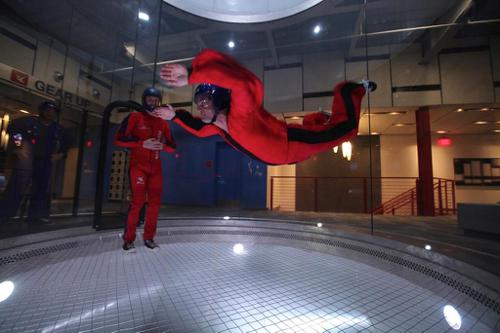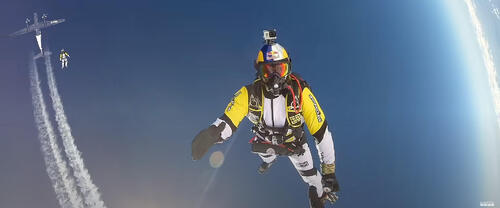Name: Juan Mayer
First Jump: 2000
Skydives: 10 000+
Helmet: Handmade
Cameras: Nikon (Photos), Sony & Panasonic (Video)
Container: neXgen (Aerodyne)
Canopy: Pilot 150
Reserve: Smart 150
AAD: Cypres
Wingsuit: Havok Carve
We recently had the pleasure of speaking with Juan Mayer, one of the most prominent skydive photographers of this decade. From his early skydiving career and his early days in photography to his recently published book.
DZ: After completing your skydiving course, how long was it before you decided that you'd want to focus on the photography aspect? Was photography something you had interest in prior to becoming a skydiver?
JM: When I started skydiving, the AFF course didn’t exist in Argentina. I started with the static line course using a reserve canopy mounted on the front. My first teacher, Mario “Perro” Rodriguez, was an amazing instructor! I did 4 static line jumps and the feeling was completely overwhelming. A year later, I came back and continued with the same instructor but this time doing tandems. It was like I discovered a completely different world to photograph and after doing only 70 skydives, I started using a video camera on my helmet. At that time the GoPros, or any of those super small cameras, didn’t exist yet, so it wasn’t that easy. I already knew that I wanted to do skydiving photography but the main reason I started taking videos was because after spending all my money on those 70 jumps, I really needed to find a way to continue skydiving. So, at the beginning I started offering my service as a videographer just for half of the price of my jump ticket.
DZ: What type of photography did you specialize in prior to skydiving photography, and were there aspects you had learned in those fields that allowed you to bring over into your approach to skydiving photography?
JM: I was mostly doing wedding photography. Well, the best thing about doing social photography is that it allows you to practice a lot with your camera, then you really get to learn many things about your equipment. With skydiving photography its harder because in freefall we don’t have a lot of time to play with the setups and different lenses. This is why I always recommend learning from other photographers, especially non-skydiving ones and the most important thing is to practice a lot and make a lot of mistakes. It will give you the skills to really know your camera equipment.
DZ: At what point did you notice that your photography could end up becoming a viable career for yourself?
JM: That's a really good question, its hard to pinpoint exactly when. The more people asked me for photos, the more it showed me how much they liked them. I then started travelling to countries close to Argentina for different skydiving events. This is when, after almost 15 years in the army, I challenged myself to take a year’s leave without salary, to see if I could pay my bills with skydiving alone. Unfortunately I wasn’t getting the same level of income as I did in the army, but it was enough to get by and it allowed me to continue skydiving. So I quit the army and decided to follow my dreams while making a living out of skydiving photography. But I still remember travelling for the first time outside of Argentina with only 57 jumps. I went to Deland in Florida, and came across the Book of Skydiving Photography by Norman Kent. I remember that moment vividly, loving every single picture I saw and it really confirmed to me what I wanted to do.
DZ: How did you go from jumping at Aeroclub Lobos in Argentina, to working for one of the largest and fastest growing dropzones in the world, Skydive Dubai?
JM: It was a very long process and it could take me hours to share all the places and moments (good and bad) I went through before I got my contract with Skydive Dubai. Basically, I was following my heart; doing what made me happy, travelling a lot, learning from other videographers and meeting many good people. Just a few anecdotes, I remember sending hundred of emails to every dropzone around the world asking for a job and one day while driving to Lobos in Argentina I got a call from New Zealand telling me that they needed me to work there, but I had to be there in a week. So, even without knowing basic English I sold my car and moved to New Zealand, a place with a totally different language to mine. I lived there for almost a year, which helped me learn English, not fluently, but enough to communicate with others.
I also remember going to Brazil to film different events where I met Craig Girard and asking him many times if I could film the AZ Challenge, which was a well known skydiving event at that time. After 3 years of asking I finally got an invitation as a one of the official cameramen, I really couldn’t believe it.
DZ: What are some of your most memorable jumps with the camera?
JM: I'm lucky, with so many years of skydiving, to have a lot of memorable jumps. But to choose a few of them, I will say, when I was filming one of my sisters doing her first tandem, it was a very special moment!
Another memorable jump was documenting an 88 way formation at the AZ Challenge. As I was filming, I watched it being completed and I really couldn’t believe I was there, as a part of that amazing event and capturing it all on camera!
And a more recent memorable jump, was in Dubai, when I filmed a skydiver that had an accident 7 years ago which left him in a wheelchair. Seeing his huge smile in freefall after 7 years of waiting for that moment was something incredibly rewarding, really hard to explain with words. I felt super lucky to be there with my cameras filming him in freefall, smiling for more than a minute nonstop!
Over the course of more than 15 years of skydiving, I’ve had a lot of memorable jumps, but this is just why I really love photography, because it allows you to capture those seconds, those special moments, forever!
DZ: Could you share with us, 3 of your favourite images that you've taken?
DZ: Are there any specific disciplines that you prefer to photograph and if so, why is that?
JM: I love to photograph any discipline. Sometimes during simple jumps such as with tandems or AFF students I’ve captured images that have made me super happy. But if I had to choose, I would prefer to photograph freestyle. I really think in our sport there is nothing more beautiful that a girl dancing in the sky!
DZ: You list Norman Kent as one of your inspirations, and state that it was your goal to take pictures that looked like his. What aspect of Norman Kent's style have you always looked up to most?
JM: Definitely, like I mentioned earlier, Norman Kent was, and still is, one of my inspirations and like every novice photographer I tried to emulate others, today I think I have my own style. But what I really like about Norman, is that he is not just focused on capturing a zoomed-in, square picture. He is always trying to show the beauty of the sky and how lucky we are as a skydivers to have such a huge and amazing playground, every single day.
DZ: A topic that is hard to avoid with all fields of photography these days is the relation between art and technology. Do you feel that the internet has been a blessing or a curse with regards to being a photographer, and why?
JM: Well, when I started skydiving photography we only had film, so we would take a photo, bring it to the store, and then wait a few days until the film was developed. So trying new things and learning different techniques was a long and costly process. We always had to be sure to use the right setup to get a good photo, because we couldn’t try again, especially when filming tandems. Today, with all the digital cameras, we can try as much as we like, which is really good in terms of money and time, but its also true that it makes us more lazy, in terms of preparing the right setups to take a nice photo. Anyways, the relation between art and technology is amazing for us as photographers. Today, within a few seconds, we can share our art and photos freely with million of peoples around the planet, which is a real blessing!
DZ: You just recently published a book titled "Ultimate High: Skydiving Behind The Lens", could you tell us a bit about the book and what it contains?
JM: Its a hard cover book with 104 pages of skydiving photography. I always wanted to publish a book with my photographs but wasn’t quite sure how to start so I met with designers and people involved with photography books. It was a very long process, choosing the photos, finding the right text, designs, meetings and more meetings, etc, etc, etc. But after 2 long years of hard work, it finally got published.
My book contains photos that I took over the years of skydiving in many different places around the world. Most of them being special moments in my life as a skydiver, shared with friends.
The book also contains narrative explaining my philosophy as a photographer and skydiver.
DZ: The release of your book is no doubt a milestone in your life, what other goals do you have set which you hope to achieve in the future?
JM: Yes it’s definitely a milestone! I have many goals, but the most important ones are to continue sharing special moments with friends and taking photos that makes me happy. And to mention a dream, I wish one day I can enjoy the sky with my little daughter doing freestyle! But of course it will depend on her, whether she likes skydiving or not :)
DZ: Thanks for taking the time to talk to us, we always love sharing your images. Do you have any last words for readers?
JM: Thank you guys so much for giving me the opportunity to show a little part of my passion for Photography and Skydiving! Just some last words, NEVER STOP FOLLOWING YOUR DREAMS!




